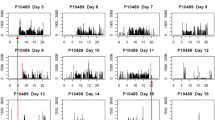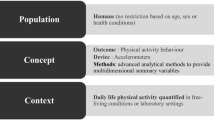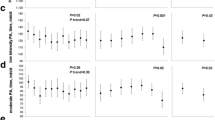Abstract
The increasing use of wearable actimetry devices in cohort studies can provide a deep and objective insight in physical activity (PA) patterns. For reliable and reproducible pattern recognition, and to minimize the influence of specific device characteristics, there is a need for a generic method to identify relevant PA events in sensor data sets on the basis of comprehensive features such as PA duration and intensity. The objectives of this paper are to present a method to identify universal event detection thresholds for such parameters, and to attempt to find stable meta-clusters of PA behaviour. PA events of 5, 10, 20 and 30 min with low, medium and high intensity thresholds found in literature and intensity deciles were computed for a random sample (N = 100) of the NHANES 2005-06 accelerometer data set (N = 7457). On the basis of all combinations of the above, activity events were detected, and parameters mean duration, mean intensity and event regularity were computed. Results were clustered using x-Means clustering and visualized for 5-, 10-, 20-, and 30-min events. Stable clustering results are obtained with intensity thresholds up to the 8th decile and for event durations up to 10 min. Two stable meta-clusters were detected: ‘irregularly active’ (intensity at 52nd percentile) and ‘regularly active’ (intensity at 42nd percentile). Distinct generic thresholds could be identified and are proposed. They may prove useful for further investigations of similar actimetry data sets, minimising the influence of specific device characteristics. The results also confirm that distinct PA event patterns – including event regularity – can be identified using wearable sensor devices, especially when regarding low-intensity, short-term activities which do not correspond to current PA recommendations. Further research is necessary to evaluate actual associations between sensor-based PA parameters and health outcome. The author identified generic intensity and duration thresholds for analysing objective PA data from wearable devices. This may contribute to further analyses of PA patterns along with their relations with health outcome parameters.





Similar content being viewed by others
References
Altini, M., Penders, J., Vullers, R., and Amft, O., Estimating energy expenditure using body-worn accelerometers: A comparison of methods, sensors number and positioning. IEEE J. Biomed. Health Inf. 19(1):219–226, 2015.
Loprinzi, P. D., Sheffield, J., Tyo, B. M., and Fittipaldi-Wert, J., Accelerometer-determined physical activity, mobility disability, and health. Disabil. Health J. 7(4):419–425, 2014.
Lee, I. M., Sesso, H. D., Oguma, Y., and Paffenbarger, R. S., Jr., The “weekend warrior” and risk of mortality. Am. J. Epidemiol. 160(7):636–641, 2004.
Manns, P., Ezeugwu, V., Armijo-Olivo, S., Vallance, J., and Healy, G. N., Accelerometer-derived pattern of sedentary and physical activity time in persons with mobility disability: National Health and Nutrition Examination Survey 2003 to 2006. J. Am. Geriatr. Soc. 63(7):1314–1323, 2015.
Haskell, W. L., Lee, I. M., Pate, R. R., et al., Physical activity and public health: Updated recommendation for adults from the American College of Sports Medicine and the American Heart Association. Circulation 116(9):1081–1093, 2007.
Glazer, N. L., Lyass, A., Esliger, D. W., et al., Sustained and shorter bouts of physical activity are related to cardiovascular health. Med. Sci. Sports Exerc. 45(1):109–115, 2013.
Kim, Y., Welk, G. J., Braun, S. I., and Kang, M., Extracting objective estimates of sedentary behavior from accelerometer data: Measurement considerations for surveillance and research applications. PLoS One 10(2), e0118078, 2015.
Marschollek, M., A semi-quantitative method to denote generic physical activity phenotypes from long-term accelerometer data--the ATLAS index. PLoS One 8(5), e63522, 2013.
Marschollek, M., Clustering physical activity phenotypes using the ATLAS index on accelerometric data from an epidemiologic cohort study. Stud. Health Technol. Inform. 205:763–767, 2014.
Centers for Disease Control and Prevention (CDC). National Health and Nutrition Examination Survey Data. U.S. Department of Health and Human Services, Centers for Disease Control and Prevention. http://www.cdc.gov/nchs/nhanes/nhanes2005-2006/PAXRAW_D.htm. Accessed 30 Oct 2013.
Witten, I. H., and Frank, E., Data mining: practical machine learning tools and techniques, Second Edition (Morgan Kaufmann Series in Data Management Systems). Morgan Kaufmann Publishers Inc., 2005.
Ried-Larsen, M., Brond, J. C., Brage, S., et al., Mechanical and free living comparisons of four generations of the Actigraph activity monitor. Int. J. Behav. Nutr. Phys. Act. 9:113, 2012.
Nelson, M. E., Rejeski, W. J., Blair, S. N., et al., Physical activity and public health in older adults: Recommendation from the American College of Sports Medicine and the American Heart Association. Med. Sci. Sports Exerc. 39(8):1435–1445, 2007.
Leys, C., Ley, C., Klein, O., Bernard, P., and Licata, L., Detecting outliers: Do not use standard deviation around the mean, use absolute deviation around the median. J. Exp. Soc. Psychol. 49(4):764–766, 2013.
Pelleg, D., and Moore, A.W., X-means: extending K-means with efficient estimation of the number of clusters. Proceedings of the Seventeenth International Conference on Machine Learning; June 29 - July 2, 2000. Stanford, CA. 657808: Morgan Kaufmann Publishers Inc., 2000. p. 727–34.
Metzger, J. S., Catellier, D. J., Evenson, K. R., Treuth, M. S., Rosamond, W. D., and Siega-Riz, A. M., Patterns of objectively measured physical activity in the United States. Med. Sci. Sports Exerc. 40(4):630–638, 2008.
Bouten, C. V., Koekkoek, K. T., Verduin, M., Kodde, R., and Janssen, J. D., A triaxial accelerometer and portable data processing unit for the assessment of daily physical activity. IEEE Trans. Biomed. Eng. 44(3):136–147, 1997.
Kruger, J., Ham, S. A., and Kohl, H. W., 3rd, Characteristics of a “weekend warrior”: Results from two national surveys. Med. Sci. Sports Exerc. 39(5):796–800, 2007.
Pincus, S., Approximate entropy (ApEn) as a complexity measure. Chaos 5(1):110–117, 1995.
Acknowledgments
I wish to thank all my colleagues for discussions about physical activity measurement and data analysis, most notably Dr. Klaus-Hendrik Wolf, Dr. Martin Kohlmann, Dr. Matthias Gietzelt, Mareike Schulze, and Michael Dölle.
Author information
Authors and Affiliations
Corresponding author
Ethics declarations
Competing interests
The author declares no competing interests.
Additional information
This article is part of the Topical Collection on Mobile Systems
Rights and permissions
About this article
Cite this article
Marschollek, M. A Method to Find Generic Thresholds for Identifying Relevant Physical Activity Events in Sensor Data. J Med Syst 40, 29 (2016). https://doi.org/10.1007/s10916-015-0383-3
Received:
Accepted:
Published:
DOI: https://doi.org/10.1007/s10916-015-0383-3




